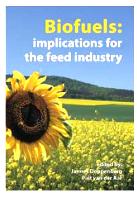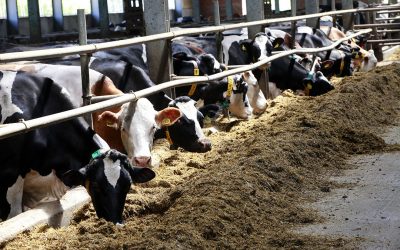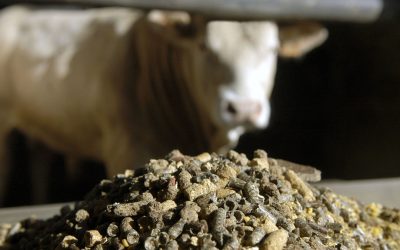Biofuels: implications for the feed industry

Increasing biofuel production in the future will have a major impact on the feed industry. Not only will the competition for food, fuel and feed decrease the availability of feedstuffs for animal production but also new feedstuffs will become available for which the nutritional qualities need to be reviewed.
The nutritional value and usability as a feedstuff of
by-products from the biofuel industry is the main focus of the book “Biofuels:
implications for the
by-products from the biofuel industry is the main focus of the book “Biofuels:
implications for the
feed industry”. The book contains full articles from a conference that was
organised by Schothorst Feed Research in October 2006.
In particular, rapeseed meal and glycerine from biodiesel production
and DDGS from bioethanol production are discussed. The book also gives an
overview of the current and future developments of the emerging bioenergy
production. Piet van der Aar, MD of Schothorst Feed Research in the Netherlands
begins with a short introduction reviewing the general implications of biofuel
production for the feed industry, concluding that the subject will be “a major
theme in our activities for the next decade.”
and DDGS from bioethanol production are discussed. The book also gives an
overview of the current and future developments of the emerging bioenergy
production. Piet van der Aar, MD of Schothorst Feed Research in the Netherlands
begins with a short introduction reviewing the general implications of biofuel
production for the feed industry, concluding that the subject will be “a major
theme in our activities for the next decade.”
At present, energy farming on current agricultural land is the major
supplier of raw materials for biofuels. A potential bioenergy supply until 2050
of up to 700 EJ/yr* is assumed for this system by researchers of the Copernicus
Institute of the Utrecht University in the Netherlands. This requires intensive
agricultural production systems. When this is not feasible the bioenergy
potential could be reduced to zero. Other potential sources for biomass
production are marginal lands (0-150 EJ/yr) and forest residues (0-150 EJ/yr).
Relatively low potential can be found in residues from agriculture (15-70
EJ/yr), dry manure (5-55 EJ/yr) and organic wastes (5-50+ EJ/yr).
supplier of raw materials for biofuels. A potential bioenergy supply until 2050
of up to 700 EJ/yr* is assumed for this system by researchers of the Copernicus
Institute of the Utrecht University in the Netherlands. This requires intensive
agricultural production systems. When this is not feasible the bioenergy
potential could be reduced to zero. Other potential sources for biomass
production are marginal lands (0-150 EJ/yr) and forest residues (0-150 EJ/yr).
Relatively low potential can be found in residues from agriculture (15-70
EJ/yr), dry manure (5-55 EJ/yr) and organic wastes (5-50+ EJ/yr).
The techno-economic potential of biomass resources for energy and
industrial materials can be very large, these researchers noted.
industrial materials can be very large, these researchers noted.
In theory, twice the current global energy demand can be produced, but more
likely around 400 EJ, without competing with food production, protection of
forests and nature. This is only expected to be reached in the second half of
this century. Total global energy use now is estimated at 430 EJ. In the US
bio-ethanol is emerging at a fast pace and has changed the face of agricultural
markets. Geoff Cooper of the National Corn Growers Association sees increasing
demand for corn parallel to an incremental rise in corn price. Therefore US
farmers are searching for substitutes to feed to their animals, which has partly
been found in dried distillers’ grains. Domestic and foreign feed buyers and
livestock producers gain a better understanding of the issues associated with
purchasing, transporting and feeding of distillers’ grains.
likely around 400 EJ, without competing with food production, protection of
forests and nature. This is only expected to be reached in the second half of
this century. Total global energy use now is estimated at 430 EJ. In the US
bio-ethanol is emerging at a fast pace and has changed the face of agricultural
markets. Geoff Cooper of the National Corn Growers Association sees increasing
demand for corn parallel to an incremental rise in corn price. Therefore US
farmers are searching for substitutes to feed to their animals, which has partly
been found in dried distillers’ grains. Domestic and foreign feed buyers and
livestock producers gain a better understanding of the issues associated with
purchasing, transporting and feeding of distillers’ grains.
Different raw materials in Europe
The situation in
Europe is slightly different to the US market. Christine Chudaske of Südzucker
AG in Germany notes that grain will be the basis for producing bio-ethanol
through sugar and sugar containing substances. As a consequence DDGS and vinasse
as co-products become more known to the market. Chudaske had a forward looking
perspective when she concluded that “bio-ethanol will also influence the grain
markets in the EU by reducing the oversupply of grains and sugar. This will
significantly impact the common agricultural policy as far as intervention
and
set aside programs are concerned.” How true this has become in less than
two years.
The situation in
Europe is slightly different to the US market. Christine Chudaske of Südzucker
AG in Germany notes that grain will be the basis for producing bio-ethanol
through sugar and sugar containing substances. As a consequence DDGS and vinasse
as co-products become more known to the market. Chudaske had a forward looking
perspective when she concluded that “bio-ethanol will also influence the grain
markets in the EU by reducing the oversupply of grains and sugar. This will
significantly impact the common agricultural policy as far as intervention
and
set aside programs are concerned.” How true this has become in less than
two years.
In Europe biodiesel is more popular than bio-ethanol in terms of crop
growing. Rapeseed is the main basis for biodiesel and its main by-products are
rapeseed meal and cake and glycerine. Karl-Heinz Südekum of the University of
Bonn in Germany concludes that glycerine may help to stabilise the hygienic
quality of pelleted feeds without compromising physical quality of pellets. In
ruminant diets it could replace rapidly fermentable carbohydrates and its sweet
taste may improve palatability.
growing. Rapeseed is the main basis for biodiesel and its main by-products are
rapeseed meal and cake and glycerine. Karl-Heinz Südekum of the University of
Bonn in Germany concludes that glycerine may help to stabilise the hygienic
quality of pelleted feeds without compromising physical quality of pellets. In
ruminant diets it could replace rapidly fermentable carbohydrates and its sweet
taste may improve palatability.
Rapeseed meal could replace soybean meal in dairy cow rations. Südekum said
that the value of rapeseed cake for all categories of farm animals would need to
be standardised, because varying crude fat and crude protein concentrations
makes the feeding value difficult to predict and could also affect storage
stability.
that the value of rapeseed cake for all categories of farm animals would need to
be standardised, because varying crude fat and crude protein concentrations
makes the feeding value difficult to predict and could also affect storage
stability.
Jannes Doppenberg of Schothorst Feed Research elaborated on the feeding
values of biodiesel by-products for non-ruminants. The key factor in this is the
anti-nutritional property of glucosinolate (GSL) in rapeseed meal or cake. The
GSL rate of rapeseed cake (expeller) is much higher than in rapeseed meal, thus
inclusion rates in pig diets need to be lower. Doppenberg said glycerine can be
used up to 5% in pig diets and 10% in poultry diets.
values of biodiesel by-products for non-ruminants. The key factor in this is the
anti-nutritional property of glucosinolate (GSL) in rapeseed meal or cake. The
GSL rate of rapeseed cake (expeller) is much higher than in rapeseed meal, thus
inclusion rates in pig diets need to be lower. Doppenberg said glycerine can be
used up to 5% in pig diets and 10% in poultry diets.
DDGS investigated
Researchers from the Prairie
Swine Centre and the University of Alberta in Canada recommend the use of DDGS
to be 10 to 15% of the diet of growing and finishing pigs. Corn derived DDGS of
certified quality might be included at higher levels. Weanling pigs are less
tolerant to DDGS and inclusions are maximised to 7 to 10%. For wheat DDGS the
researchers limit intake to 5 to 10% in diets of growing and finishing pigs.
With higher inclusions they fear for depressed feed intake.
Researchers from the Prairie
Swine Centre and the University of Alberta in Canada recommend the use of DDGS
to be 10 to 15% of the diet of growing and finishing pigs. Corn derived DDGS of
certified quality might be included at higher levels. Weanling pigs are less
tolerant to DDGS and inclusions are maximised to 7 to 10%. For wheat DDGS the
researchers limit intake to 5 to 10% in diets of growing and finishing pigs.
With higher inclusions they fear for depressed feed intake.
DDGS has 110-130% the energy of corn for growing and finishing cattle
according to Larry Berger, beef nutritionist at the University of Illinois. He
notices the potential concern of variability in composition when feeding DDGS.
University of Wisconsin researchers found that DDGS is an excellent source of
nutrition for lactating cows. Dry matter intake responses are most favourable
when DDGS is fed for 5-15% of the diet. “Growing and finishing cattle offer the
greatest opportunity for the utilisation of DDGS in the US,” Berger said.
according to Larry Berger, beef nutritionist at the University of Illinois. He
notices the potential concern of variability in composition when feeding DDGS.
University of Wisconsin researchers found that DDGS is an excellent source of
nutrition for lactating cows. Dry matter intake responses are most favourable
when DDGS is fed for 5-15% of the diet. “Growing and finishing cattle offer the
greatest opportunity for the utilisation of DDGS in the US,” Berger said.
In-depth view
The book gives an in-depth view of
research and opportunities for the livestock industry regarding the use of
biofuel by-products. It is amazing to see that within two years time the market
has evolved so quickly, that while these presentations are still viable, a new
conference on the same subject could be justified.
The book gives an in-depth view of
research and opportunities for the livestock industry regarding the use of
biofuel by-products. It is amazing to see that within two years time the market
has evolved so quickly, that while these presentations are still viable, a new
conference on the same subject could be justified.
Source: Feed Tech Volume 12 No.
7
7











